The Infamous Burp Hollow, San Francisco Nightclub, 1956-66
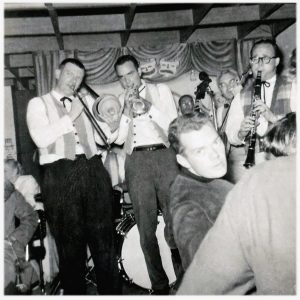
Musicians and denizens of Burp Hollow in their natural habitat. L to R: Bob Mielke (trombone), Ted Butterman (cornet), Bill Erickson (piano), Pete Allen (bass), Dick Oxtot (banjo) and Bill Napier (clarinet). Courtesy of Ted Butterman.
“A seamy hole in the wall on Broadway — the booming entertainment strip of North Beach — this joint was near the bottom of the long list of jazz rooms flourishing in San Francisco around 1960.”
— Clarinet player Bill Carter, 2014
A Colorful Nightclub and Low Dive
Hearing the name Burp Hollow today musicians cringe, remembering the bad pay and tiny stage, watered-down booze and unsavory owner, a wheel chair-bound former Mafioso. The quirky venue is ruefully recalled for its ridiculous four-by-six foot dance floor and the confusing “Bob Mielke Bearcats Dixie Jazz” sign on the wall regardless of who was playing.
But in the crowded North Beach entertainment district of San Francisco, the insistent sound of lively jazz horns was a magnet to the busy nighttime foot traffic on Broadway near Columbus. Jazz fans and tourists were drawn to this nightclub by the lively sounds of Dixieland and Traditional jazz.
Burp Hollow might have passed quietly into colorful Frisco legend if not for discovery of audiotapes preserving performances by bright talents of the West Coast jazz revival. The recovered music represents strongly contrasting styles distributed along the two-beat vs. four-beat Jazz spectrum.
Runkle’s Review
In a self-published 1978 monograph, Bay Area Jazz Clubs of the Fifties, washboard player and jazz superfan Brett Runkle put Burp Hollow in the category of “beer-and-peanuts joints.” This was a triple entendre. Free peanuts encouraged beverage consumption. Musicians were paid only a few bucks (“peanuts”) and beer was free for the musicians, a major component of their compensation.
The Burp also sold hard liquor, though their cocktails were highly suspect and notoriously weak. Runkle reports that these clubs were “pitched to college kids or singles in their early twenties” and usually had, “sawdust on the floors and Greek letters on the walls.”
The meanest of dives, Burp Hollow had a singular appeal: the music. Yet Runkle’s depiction suggests a memorable slice-of-life zest:
“A gorgeous manikin sat at a barstool as a come-on for male tourists. A hard-bitten jazz hound once bought it a drink. (Very embarrassing!) The Burp could stretch one bottle of booze over about 200 drinks so it was smart to order beer. They hired The Bearcats, various Oxtot combinations and also Le Sharpton’s group. Almost everybody worked or sat in there in the next eight or ten years.”
Millio Militti, Baby!
Burp Hollow’s owner-operator Millio Militti was interviewed for a San Francisco newspaper in 1965. The flamboyant Sicilian-American claimed to have been a contender for the welterweight boxing title in the 1930s. But the story that he was, “hit by a bullet in an accident that left him paralyzed” didn’t quite add up. “Baby, there’s a bad page in everyone’s life, and that was mine.”
Apparently, the shooting that left him in a wheelchair was related to his former mafia activities in the Midwest. Fleeing to the Coast, he’d managed to put together and operate Burp Hollow with the help of immediate family and friends for nearly a decade. Rumor had it that tucked under the blanket always on his lap he kept a firearm.
Militti explained the manikin. Sure, she was a draw for single male convention-goers, merely a conversation starter to make friends. When the reporter commented on his tending bar in a wheelchair Militti said, “That’s right, baby, and I can move pretty fast. That place is my life, and people are beautiful.”
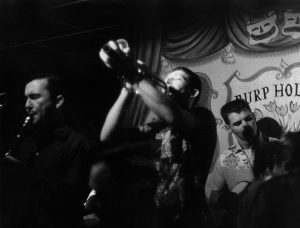
Earl Scheelar playing cornet at Burp Hollow, c. 1960. He recalls, “Millio Militti came to the Honeybucket, talked to Frank Goulette about playing on weekends at Burp Hollow. And so we played Friday and Saturday nights . . . and then after that, everybody played at Burp Hollow.” Photo by Tony Standish.
Battle of the Bands: Two-beat vs. Four-beat
Of course it’s silly to call this a battle of the bands. Most of these cats knew and worked with each other for years in both styles. Yet there is truth to the notion of a Frisco vs. East Bay musical split.
In general, San Francisco musicians played two-beat rhythm with tuba and banjo. By contrast in the East Bay, the Berkeley crowd preferred a four-beat sound favoring string bass or sometimes tuba. San Francisco-based bands like Original Inferior Jazz Band favored the two-beat style of Lu Watters’ Yerba Buena Jazz Band emphasizing tuba and banjos that became wildly popular is San Francisco 1940-50.
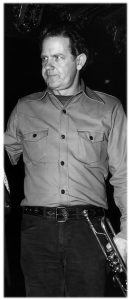
Cornet player Ev Farey played with the Original on occasion. He led or co-led Bay City Jazz Band. Courtesy Ev Farey.
Original Inferior/Superior Jass Band (1953-64)
After Yerba Buena disbanded, several Traditional Jazz ensembles emerged in the Bay Area to keep the two-beat jazz style alive: Bay City Jazz Band (co-led by cornet player Ev Farey), Great Pacific Jazz Band and Original Inferior Jazz Band. Though they often lacked the two cornet lineup, these ensembles carried forward the romping Yerba Buena spirit in a continuing Northern California wave, 1950s-80s.
Loud, brash and salty, Original Inferior (and its sibling Original Superior) played Burp Hollow, 1956-64. They had excellent soloists, good ensemble spirit, and powerful dynamics steeped in Jazz sounds of the 1920s interpreted Watters style. Like Yerba Buena, they utilized two banjos; one of them was Ed Sprankle the amateur recordist who taped this session.
This was one of several bands created by Frank Goulette to play music in the Watters manner. They made no commercial records, no photographs have surfaced and this is first publication of their music. Their name was likely a self-effacing reference to an early New Orleans jazz ensemble — Original Superior Jazz Band.
While ‘The Burp’ was a medium sized club (according to Runkle) it had a tiny stage and smaller dance floor. This seven or eight piece lineup must have been a tight squeeze, and loud in the Watters tradition. Unfortunately this archaeological audio fails to transmit the huge crescendos and sheer dynamic force generated by an acoustic ensemble of this size and commitment.
Ev Farey recalled Burp Hollow’s suggestive but inanimate mascot in 2015:
“She was actually pretty, a lifelike manikin. She was sitting at the first barstool as you came in the door, her legs were crossed and she’s sitting reading the paper. She was wearing a cap, a hat. It was pointed I seem to remember. She was pretty funny.” And she fooled a lot of people. You stand on the stage and you can see her. Guys would come in, turn and start to say something and then realized . . .
- (Page 1 of 2)
- Next page →

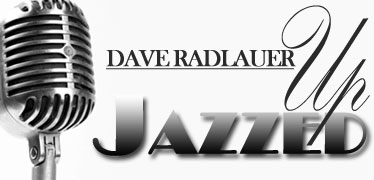
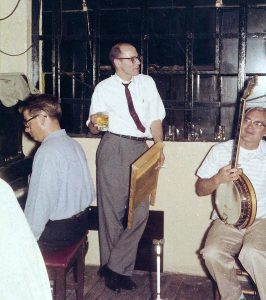
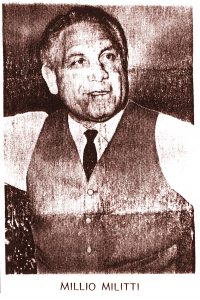
The story of Burp Hollow and classic jazz continue at the Jazz Rhythm website:
http://jazzhotbigstep.com/104.html
Burp Hollow http://jazzhotbigstep.com/400333.html
Dick Oxtot http://jazzhotbigstep.com/486423.html
Bill Erickson http://jazzhotbigstep.com/249912.html
Ev Farey http://jazzhotbigstep.com/773265.html
Bill Napier http://jazzhotbigstep.com/400312.html
Nice work, Dave
There were also plenty of smaller bands at Burp Hollow some of which I played in around 1959-60: Oxtot’s smaller (not Watters) configurations, like Walt Yost on tuba, Oxtot banjo and vocals or cornet, me on clarinet, and wonderful Bill Erickson on piano. Once, when we were late by 2 minutes getting back to the stand after a break, Emilio barked over customers’ heads across the room, “Hey Oxtot! You guys want to keep working here or not?”
A great article, Dave. I remember being there at Burp Hollow and also playing with Frank G. at the Honeybucket. I did some recording while there and put out a cd Tradjazz Productions TJP 2141 which is still available. Wish those days still existed!
Thanks for your jaded memories of The Burp.
Max Leavitt says it he wasn’t the vocalist on “Blues Jumped a Rabbit”.